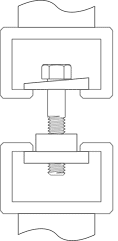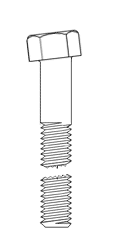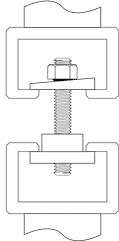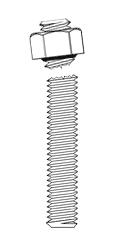When a threaded rod with a nut is substituted for a bolt with a forged head, two issues come into play. When in-house mechanical testing was performed by Portland Bolt on headed bolts versus rods with a nut, both from the identical lots of steel, the rod with a nut developed up to 12% less strength than the comparable headed bolt. The reason for this reduction in strength on the rod with nut is that the stress area at the junction of the rod and nut (which is substituting for the forged bolt head) is significantly reduced. Because the minor diameter (root) of the threads is significantly less than the full-size diameter of the unthreaded shank on a headed bolt, the rod with nut often breaks at a much lower strength than a headed bolt. More importantly, even if the rod with nut does develop enough strength to meet the specification, it will often break at the junction of the nut which is acting as the head of the bolt when wedge tested per ASTM F606. For this reason, technically a rod with a nut in lieu of a headed bolt will frequently fail mechanical testing because the head (nut in this case) comes off before the bolt breaks in the body or threaded section of the fastener which constitutes an automatic failure.
We often see fastener distributors and manufacturers without forging capabilities talking customers into switching from a headed bolt to a rod with a nut since they are unable to provide the forged product that was engineered into the structure. We see this most frequently with regard to headed anchor bolts. Making the decision to switch from a bolt with a forged head to a rod with a nut should always be approved the Engineer of Record to prevent any liability in making such a substitution should a failure of the fasteners occur.
Wedge Testing per ASTM F606




Note: Wedge testing as shown above is required to obtain mechanical properties for most ASTM high strength fasteners. A greater difference was found for high-strength fasteners than mild steel fasteners during Portland Bolt in-house testing of headed bolts versus rods with a nut. The reduced cross-sectional area at the junction of the nut as compared to a bolt with a forged head caused the fasteners with a nut acting as a bolt head to break at lower strengths than the bolts with forged heads. Additionally, the high strength rods with a nut acting as a head broke just below the nut which would automatically constitute a failure since the wedge test requires the bolt to break either in the body of the bolt or in the threaded portion, not at the junction of the head.
Thank you sharring
We’ve had a few instances where the bolt head snapped off causing catastrophic failure. Never happened in the nut-end of the bolt. Root cause was stress corrossion cracking which developed at the head. Microscopy of new bolt revealed cracks attibutable to manufacturing defects. We’re considering threaded rod at the moment, quatliy-controlling every bolt head isn’t practicable.
I have 48mm Dia bolts with washer nut and embedded in concrete 25mpa with small 5mm thick me plates at ends acting as head nut will it fail enough embedment length as per rod Dia provided please guide
@Jeevan- We are sorry, but we are unable to answer this question. You will need to contact an engineer familiar with your project.
Would 12% have mattered in a bridge build? On say a 1 3/4 inch threaded steel PT rod? And would you happen to know how far in inches you could stretch a 25 foot long 1 3/4 inch threaded PT ROD? I read over 1 inch closer to 2. That seemed rather unbelievable to me. Clearly I don’t know squat about it. The formula I found doesn’t make sense. I completely understand if you ignore me.
@Barbara- It is hard to say if a 12% difference would make a difference in your application. As for the amount of stretch, in 25 feet, I think an inch or two is reasonable, but I do not have any hard data to back that up.
What is your opinion on why many distributors are walking away from headed / forged bolt products and trying to convince their customers to move away from headed bolt products. Is there a lack of headed bolt products available for distributors or manufacturers to procure? Does no one stock headed anchor bolt products that can be cut and threaded to specification? Is there a large cost difference between headed bolts and rods with nuts welded making it uneconomical for distributors / manufacturers to want to source headed bolts?
@Mike- This has been a problem for us for quite some time. Many distributors or manufacturers to not have access to hot forged product, so they try and push a rod with a nut as an equivalent, which is of course not entirely true. Hot forging does require special equipment that many rod shops do not possess. Headed bolts are usually a bit less expensive, but it will depend on the specifics of the nee; size, grade, quantity, etc. Portland Bolt has several hot forgers and can make specials in a reasonably short time frame. Additionally, we stock several common headed anchor bolt sizes in both plain and galvanized.